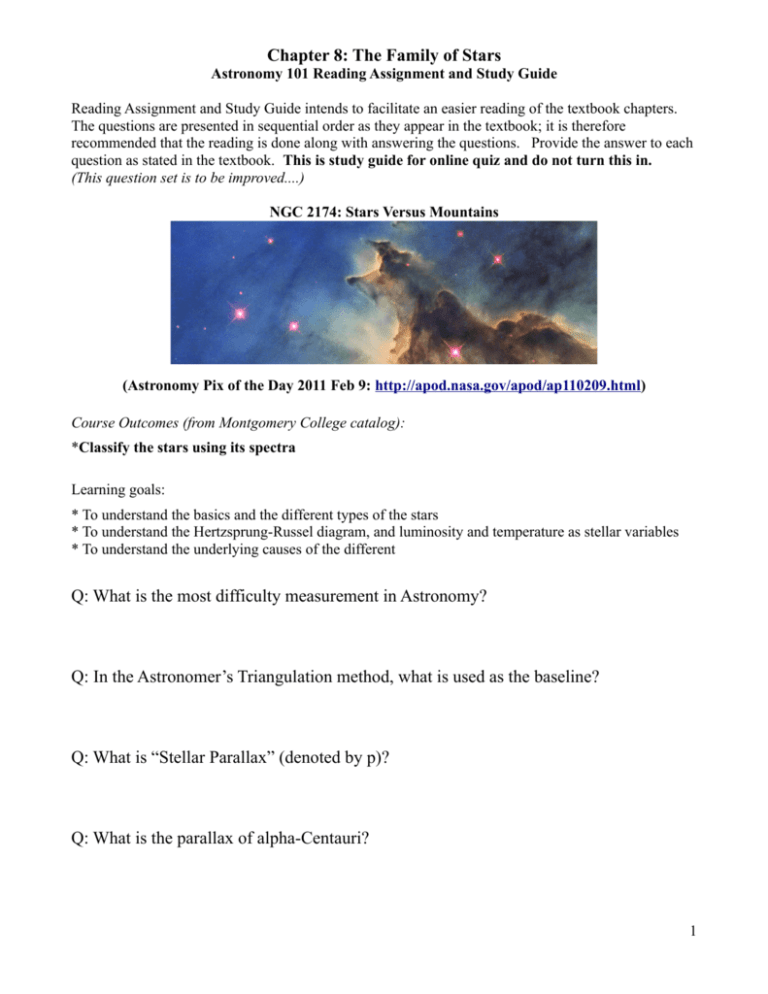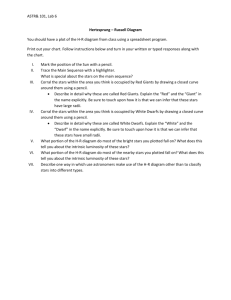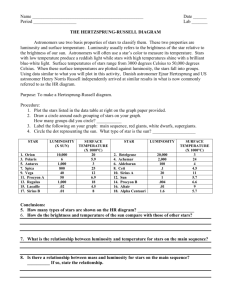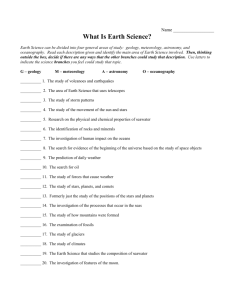Ch8 Family Of Stars Study Guide PDF
advertisement

Chapter 8: The Family of Stars Astronomy 101 Reading Assignment and Study Guide Reading Assignment and Study Guide intends to facilitate an easier reading of the textbook chapters. The questions are presented in sequential order as they appear in the textbook; it is therefore recommended that the reading is done along with answering the questions. Provide the answer to each question as stated in the textbook. This is study guide for online quiz and do not turn this in. (This question set is to be improved....) NGC 2174: Stars Versus Mountains (Astronomy Pix of the Day 2011 Feb 9: http://apod.nasa.gov/apod/ap110209.html) Course Outcomes (from Montgomery College catalog): *Classify the stars using its spectra Learning goals: * To understand the basics and the different types of the stars * To understand the Hertzsprung-Russel diagram, and luminosity and temperature as stellar variables * To understand the underlying causes of the different Q: What is the most difficulty measurement in Astronomy? Q: In the Astronomer’s Triangulation method, what is used as the baseline? Q: What is “Stellar Parallax” (denoted by p)? Q: What is the parallax of alpha-Centauri? 1 Chapter 8: The Family of Stars Astronomy 101 Reading Assignment and Study Guide Exercise: The thickness of a sheet of paper is about how many arc seconds when hold at arm's length with the edge facing you? Q: The term “parsec” is derived from what two terms and what is it a measure of? Q: Earth's atmosphere blurs astronomical observations by what angular measure and resolution? Q: Ground-based astronomers have not been able to measure the distance to stars further than what distance and why? Q: Ground-based astronomers have measured the parallax of how many stars? 8-2 Intrinsic Brightness Q: What is intrinsic brightness? Q: Why can't astronomers simply look at a star and know its intrinsic brightness? Q: What is flux? Q: What is the first, direct, and the actual measurement in the observations of stars? 2 Chapter 8: The Family of Stars Astronomy 101 Reading Assignment and Study Guide Q: Absolute visual magnitude (Mv) is standardized and referenced at what distance? http://en.wikipedia.org/wiki/Absolute_magnitude Q: What is the Sun's absolute visual magnitude? Q: If the Sun is 10 pc away, how will it appear? Q: The intrinsically faintest stars emit about how much less light (compared to the Sun)? Q: What is Luminosity? Q: Absolute magnitude system includes which part of the electromagnetic spectrum? Q: Why must astronomers correct for absolute magnitude system to obtain luminosity? Class Discussion - Bonus: If the absolute magnitude of a star is five magnitude brighter than the Sun, how many times more luminous it is? http://outreach.atnf.csiro.au/education/senior/astrophysics/photometry_luminosity.html http://www.stargazing.net/david/constel/magnitude.html http://en.wikipedia.org/wiki/Luminosity 3 Chapter 8: The Family of Stars Astronomy 101 Reading Assignment and Study Guide Q Extra :What is the luminosity of Aldebaran in comparison to the Sun? Q: What is the (estimated) range of luminosities of stars? 8-3 The Diameters of Stars Q: How do astronomers determine the size of stars? Short question - Bonus: discuss how luminosity depends on area of an object. Give a numerical example. Q: The H-R diagram plots which variables? Q: To what variable does the “spectral type” of a star, on the H-R diagram, correspond? Q: The main sequence in the H-R diagram includes what percentage of all normal stars? Q: What is the Luminosity and Temperature of the Sun as shown on the H-R diagram? Q: What is the name for the category of Stars above and to the right of the main sequence on H-R diagram? Q: What is the name for the category of Stars at the lower regions of the H-R diagram? 4 Chapter 8: The Family of Stars Astronomy 101 Reading Assignment and Study Guide Q: Most of the main sequence stars are similar in size. What is their size range? Q: White dwarfs are closer in size to which object? Q: What is the range of star size? (Bonus) Q: By the H-R diagram on p 141, what is the approximate size of Aldebaran and Polaris? Q: What is the largest a Giant Star can be? Q: How does the size of a star affect the shape of its spectral lines? Q: How are the luminosity classes determined? Discussion: Discuss Luminosity Class, give an example of each, and how it is used. **CORRECTION: on the bottom of page 144, the apparent magnitude of Betelgeuse is stated as about 0.05. The authors clearly meant “0.5” instead!! http://en.wikipedia.org/wiki/Betelgeuse (Proof: use the corrected value and distance-magnitude relation on p. 139 to find the distance → 0.5 – (-7.2) = -5 + 5 log d ) Question – Bonus: Go through “Scientific Argument” on p. 144, and then answer the question “why white dwarfs must be small stars” 5 Chapter 8: The Family of Stars Astronomy 101 Reading Assignment and Study Guide ---------------------------------------------------------------------------------------------------------Binary stars and spectroscopic methods will not be covered. The following questions are meant to guide self-learning for interested students only. Q: What force pulls the two stars in a binary system toward one another (and then into orbit around one another)? Example: animation of stars in binary system: http://www.youtube.com/watch?v=1kFFwHkxBiI Q: Name one of the best-known eclipsing binaries visible to the naked eyes ---------------------------------------------------------------------------------------------------------8-5 A Survey of the Stars Discussion: Study p 154-155 and discuss 3 important points about surveys of stars Q: How are main sequence stars ranked by mass, as on the HR diagram? Q: How are off main sequence stars ranked by mass, as on the HR diagram? Q: What is the mass-luminosity relationship? http://en.wikipedia.org/wiki/Mass%E2%80%93luminosity_relation (also on page 153) Q: Rank the star groups (main sequence, giants, dwarfs) by density from lowest to highest. 6








